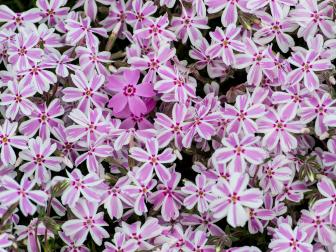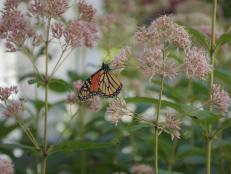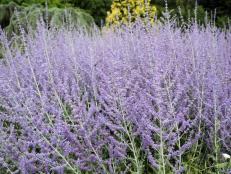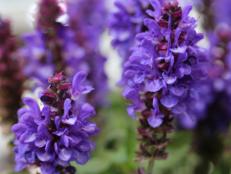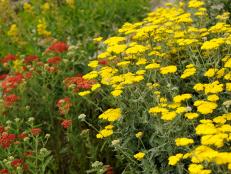Planting and Growing Garden Phlox
Learn how to plant, grow and care for this perennial charmer in your garden.

A nectar-rich and stable phlox cultivar, 'Bright Eyes' is a pollinator magnet. While some other cultivars revert back to the standard pink phlox, 'Bright Eyes' does not. Avoid watering overhead as that will cause mildew problems for most phlox.

Garden phlox, Phlox paniculata, is one of the stars of the summer show. These pretty perennials make a great backdrop for mixed beds and borders, and their fragrant blooms are nearly irresistible to butterflies and hummingbirds. The flowers are also good for cutting and enjoying in vases.
Most garden phlox will grow in USDA hardiness zones 4 to 8. For best results, do a soil test before planting, to see what amendments, if any, you may need (soil test kits are available from garden centers, or your local county extension service may be able to test a soil sample for you).
Planting Garden Phlox
Prepare your ground by tilling or hoeing about a foot deep, and mix in plenty of compost before planting. Give your phlox about an inch of water each week, if rainfall isn’t sufficient, and keep them deadheaded to encourage more blooms. Most will do best in full sun but can tolerate partial shade.
15 Phlox Plants to Try in Your Garden 15 Photos
Masses of cheery blossoms define the many phlox varieties available in garden stores, adaptable to many gardens and garden styles.
It’s a good idea to stake garden phlox as it begins to grow, so summer rains and wind won’t break the plants when they’ve reached their full height. Add a layer of mulch around them to help conserve moisture in the soil.

PerennialResource.com
Tall garden phlox (Phlox paniculata) is an old-fashioned perennial that fills midsummer with perfumed color. Flowers open in shades of pink, red, purple, white and various bicolor combinations. The blooms release a sweet fragrance that wafts through the garden on sultry summer days. This beauty is sold as Flame Series Coral garden phlox. The Flame Series is a group of naturally dwarf, compact garden phlox that grows 15 to 18 inches tall—a perfect height for containers, front of the border or courtyard gardens. Plants boast strong disease resistance and a naturally bushy form. Hardy in Zones 3-8.
Pruning
After your plants are killed back by frost, snip the stems to approximately two inches above the ground.
Dividing
You’ll need to divide them every two to three years to keep them thriving.
Diseases
Powdery mildew is probably this plant’s biggest enemy; it springs up when the weather is hot and humid, making garden phlox a challenge to grow in some regions, such as Southern climates. But developers have introduced many new varieties that are resistant to powdery mildew, and you can help prevent it from attacking your plants by spacing them far enough apart to ensure good air circulation (about one to two feet, for most types). They’ll also benefit from being watered with soaker hoses or drip irrigation, rather than sprinklers or hoses that get their foliage wet.
Pests
Insect pests can be a problem with phlox, too, so keep an eye out for spider mites and other bugs, especially in hot, dry climates or conditions. Use an insecticidal soap for control, spraying it early in the day; the spray may damage the leaves once the temperature rises.

BallFlora/Selecta
Phlox Gisele
Phlox paniculata cultivars to try in your garden:
- ‘David’ - This is a powdery mildew-resistant plant that grows 2 to 4 feet tall with fragrant white flowers. Don’t let this one dry out before you water.
- ‘Peppermint Twist’ – At only 16 inches tall, this phlox is good for planters and window boxes. The sweetly striped white and pink flowers smell like vanilla and cloves.
- ‘Katherine’ – Another disease-resistant cultivar, this phlox bears lilac-blue flowers with white “eyes” and grows 2 to 3 feet tall.
- ‘John Fanick’ – This phlox can tolerate a lot of heat and grows even in parts of Texas where other garden phlox cultivars fail. It reaches 3 feet tall and produces light pink flowers with dark pink centers.
- ‘Shortwood’ – Only its name is short; this phlox grows to 48 inches or more. Its fragrant flowers are purplish-pink. In trials, it has shown strong resistance to powdery mildew.
Creeping Phlox
Another popular kind of phlox is creeping phlox, or Phlox subulata, a spring bloomer that grows only about 6 inches high. Its evergreen leaves form a thick mat, making it useful as a ground cover. Look for this perennial plant with pink, lavender, white, red and bluish-purple blooms.
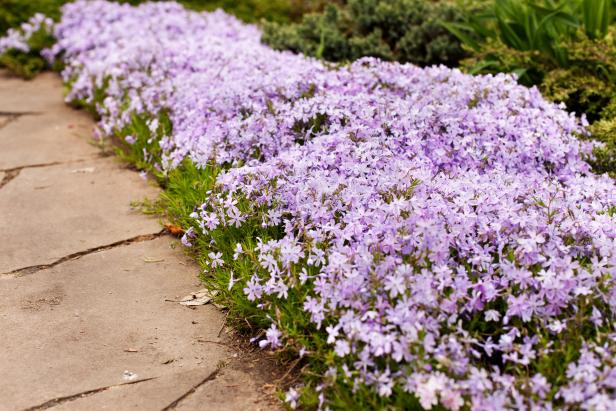
Shutterstock/speakingtomato
Creeping phlox makes a great perennial groundcover.
Creeping phlox is a good choice for a rock garden or border, and it’s pretty when it’s allowed to spill in colorful waves over a wall. It needs full to part sun and is drought-tolerant once it’s established. You may find it sold as moss phlox.
Growing Creeping Phlox and Moss Phlox Groundcovers
Learn how to select the perfect phlox ground cover for your garden, and how to grow both creeping phlox and moss phlox successfully.






